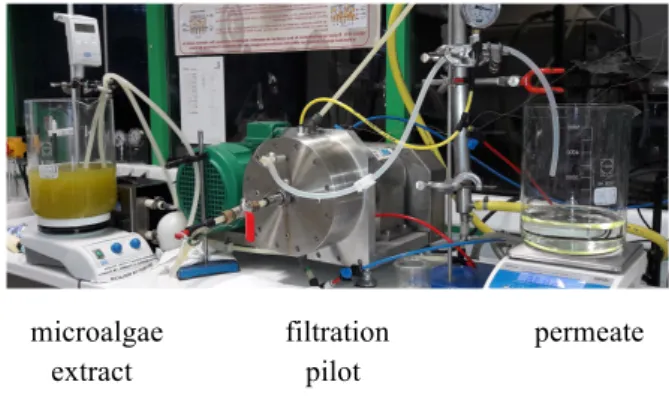HAL Id: hal-01893857
https://hal.archives-ouvertes.fr/hal-01893857
Submitted on 11 Oct 2018
HAL is a multi-disciplinary open access archive for the deposit and dissemination of sci-entific research documents, whether they are pub-lished or not. The documents may come from teaching and research institutions in France or abroad, or from public or private research centers.
L’archive ouverte pluridisciplinaire HAL, est destinée au dépôt et à la diffusion de documents scientifiques de niveau recherche, publiés ou non, émanant des établissements d’enseignement et de recherche français ou étrangers, des laboratoires publics ou privés.
Membrane filtration for the recovery of lipids from
microalgae extracts
S. Liu, L Villafaña López, E Clavijo, P. Bourseau, M. Frappart, E Couallier
To cite this version:
S. Liu, L Villafaña López, E Clavijo, P. Bourseau, M. Frappart, et al.. Membrane filtration for the recovery of lipids from microalgae extracts. Euromembrane, Jul 2018, Valencia, Spain. �hal-01893857�
Membrane filtration for the recovery of lipids from microalgae
extracts
S. Liu*/**, L. Villafaña López*, E. Clavijo *, P. Bourseau*, M. Frappart*, E. Couallier*
* CNRS, Université de Nantes, Laboratoire GEPEA, St Nazaire, France **ADEME, French Environment and Energy Management Agency, Angers, France Keywords: microalgae, biomolecules fractionation, ultrafiltration; lipid protein separation;
Introduction
Biorefinery of microalgae offers opportunities to substitute biomolecules (lipids, proteins, polysaccharides, pigments etc.) to traditional raw material in various industry sectors such as food and feed, cosmetics, pharmacy, energy or green chemistry. For large-scale production, wet processing of biomass has been proposed in order to save energy (by lowering the dewatering rate) and to be sparing with thermolabile molecules. Membrane filtration is well suited for such purposes and is therefore a promising process for the downstream processing. In this work we focus on the recovery of lipids from aqueous extracts of microalgae. After the culture of two strains, Nannochloropsis gaditana and Parachlorella Kessleri, in starving conditions to enhance their lipid production, the micro-organisms were ground and the resulting mixture were centrifuged to extract aqueous fractions containing a large quantity of dispersed lipids. This aqueous extract was then characterized and a model mixture was formulated to mimic the lipid profile and dispersion. As the control of the culture starvation and lipid production is difficult, this model solution facilitated the comparison of the filtration processes. Then model mixtures and real ones were filtrated on a plane cross flow filtration pilot and in a dynamic filtration pilot. The objective of the work was to compare the performances of the two systems and to assess the potential of membrane filtration for the separation of lipids from aqueous microalgae extracts. In real extracts, hydrophilic compounds (proteins and polysaccharides) were also present. Therefore, their concentration was also measured to evaluate the membrane selectivity between lipids and hydrophilic compounds.
Material and Methods
The microalgae extracts were produced and analysed according to the protocol described previously by E. Clavijo et al. (Clavijo et al., 2016). The model mixture was then formulated as an emulsion containing two vegetable oils, phospholipids and glycolipids in the same proportions as in the aqueous extract, with similar total fatty acids content.
Two filtration systems were used: a crossflow filtration module (CFM) and a dynamic filtration module (DFM) equipped with a polyacrylonitrile membrane (500 kDa) previously selected (Clavijo et al., 2017; Villafaña López, Clavijo, Liu, Couallier, & Frappart, 2017). The filtration performances (selectivity, flux, fouling, coalescence of the lipid droplets and cleanability) were evaluated using different analytical methods: gravimetry, gas chromatography to quantify the lipid analysis, BCA method for proteins and Dubois method for polysaccharides. The particle size distribution was measured by microscopy and laser granulometry to evaluate the coalescence.
Results and Discussion
The polyacrylonytrile membrane showed low fouling properties with the model mixture. Coalescence of oils droplets seems to appear beyond 10% (w/w) of oil in the retentate, especially during dynamic filtration. These filtration conditions improved water permeation, and, by delaying fouling phenomena, allowed to work at higher critical transmembrane pressure (TMP) (figure 1). The same conditions of dynamic filtration were tested on real extracts and promising results were obtained: the lipids were retained and a fraction of proteins permeated through the membrane. The figure 2 presents the real microalgae extract before and after filtration.
Figure 1: Comparison of the normalized flux versus the volume reduction factor (VRF) with the model solution, for cross-flow (CF) and rotating disc (RD) filtrations.
microalgae filtration permeate extract pilot
Figure 2: dynamic filtration of real microalgae extracts (supernatant of ground Nannochloropsis gaditana
cultivated in starving conditions)
Conclusions
These results confirm the pertinence of a filtration step into the downstream processing for the biorefining of microalgae and more specifically for the recovery of lipids. The optimization of the selectivity between lipids and proteins will need further studies.
References
Clavijo, E., Montalescot, V., Viau, M., Kucma, D., Bourseau, P., Frappart, M., . . . Couallier, E. (2016).
Characterization of lipids produced by parachlorella kessleri, cultured under nitrogen starving conditions (oral). Paper presented at the 12th international conference on Renewable
Ressources and Biorefineries, Ghent, Belgium.
Clavijo, E., Villafaña López, L., Liu, S., Bourseau, P., Frappart, M., Monteux, C., & Couallier, E. (2017). Understanding microalgae lipids recovery by membrane processes: cross flow
filtration of a representative synthetic mixture (o/w emulsion) (oral). Paper presented at the
10th World Congress of Chemical Engineering (WCCE), Barcelone, Spain.
Villafaña López, L., Clavijo, E., Liu, S., Couallier, E., & Frappart, M. (2017). Shear-enhanced
membrane filtration of synthetic microalgae lipid fractions for applications in biorefinery (poster). Paper presented at the 6th congress of the international society for applied phycology
(ISAP), Nantes, France.
0 0.2 0.4 0.6 0.8 1 1.2 0 1 2 3 4 5 Js /J 0 VRF CF, ˙max= 16 000 s1, Pw= 0.2 bar RD (365 rpm), ˙max= 16 000 s1, Pw= 0.2 bar RD (800 rpm), ˙max= 66 000 s1, Pw= 0.5 bar
